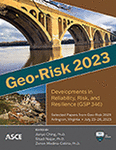Fragility Assessment of Levee Relief Wells during River Flooding
Publication: Geo-Risk 2023
ABSTRACT
Levees can be subjected to excessive underseepage through their alluvial foundations during high water periods, which is abated by the installation of relief wells. The USACE uses a modified version of the blanket theory to design relief wells. However, there are significant uncertainties in the performance of relief wells when compared to field observations. Therefore, this study presents a reliability analysis to examine the probability of failure for relief well systems and examine the controlling parameters. This was accomplished using a generic 3D MODFLOW-USG model and a random forest regression model. The results from MODFLOW simulations were used for sensitivity analysis and for training a random forest model, which was used to perform Monte Carlo simulations to develop fragility curves. The sensitivity analysis results showed that the entry and exit distance and the aquifer’s hydraulic conductivity exhibit the greatest impact on total head. Fragility curves based on uniform random values of the design parameters showed that the probability of failure does not vary significantly as the well spacing increased. These findings show that there is a potential to decrease the economic cost since the well spacing does not affect the performance of relief wells significantly.
Get full access to this article
View all available purchase options and get full access to this chapter.
REFERENCES
Alfortish, M., Brandon, T., Gilbert, R., Stark, T., and Westerink, J. (2012). “Geotechnical Reconnaissance of the 2011 Flood on the Lower Mississippi River.”, National Science Foundation, 40.
Cadigan, J. A. (2019). “Design Trends and Guidance for Substratum Pressure Relief Wells for Dams and Levees Using Computational Methods.” Dams & Levees: Bulletin of the U.S. Society on Dams(179).
Camillo, C. A. (2012). Divine Providence: The 2011 Flood in the Mississippi River and Tributaries Project, Mississippi River Commission, Vicksburg, Mississippi.
Chen, Y.-H., Tsai Frank, T. C., Cadigan Jack, A., Jafari Navid, H., and Shih, T.-H. (2021). “Relief Well Evaluation: Three-Dimensional Modeling and Blanket Theory.” J Geotech Geoenviron, 147(8), 04021054.
Chen, Y. H., Tsai, F. T. C., Cadigan, J., Jafari, N., and Harrouch, I. (2019). “Underseepage Assessment and Relief Well Evaluation for New Orleans.”.
Chen, Y. H., Tsai, F. T. C., Cadigan, J., Jafari, N., Shih, T. H., and West, T. E. (2018). “Mississippi River Levee Underseepage Assessment, North of Baton Rouge, Louisiana.” AGU Fall Meeting Abstracts.
Dehotin, J., Vázquez, R., Braud, I., Debionne, S., and Viallet, P. (2011). “Modeling of hydrological processes using unstructured and irregular grids: 2D groundwater application.” Journal of Hydrologic Engineering, 16(2), 108–125.
Fisk, H. N. (1946). Results of Geological Investigations of the alluvial valley of the lower Mississippi River: Lectures 3-4, Application of geological studies. USACE, Vicksburg, MS.
Hird, C. C., Marsland, A., and Schofield, A. N. (1978). “The Development of Centrifugal Models to Study the Influence of Uplift Pressures on the Stability of A Flood Bank.” Géotechnique, 28(1), 22.
Jafari, N. H., Cadigan, J. A., Stark, T. D., and Woodward, M. L. (2019). “Phreatic Surface Migration through an Unsaturated Levee Embankment.” J Geotech Geoenviron, 145(11), 05019010.
Kolb, C. R. (1975). Geologic Control of Sand Boils Along Mississippi River Levees. Soils and Pavements Laboratory, US Army Engineers Waterways Experiment Station.
Low, B. (2014). “FORM, SORM, and spatial modeling in geotechnical engineering.” Structural Safety, 49, 56–64.
Panday, S., Langevin, C. D., Niswonger, R. G., Ibaraki, M., and Hughes, J. D. (2013). MODFLOW-USG version 1: An unstructured grid version of MODFLOW for simulating groundwater flow and tightly coupled processes using a control volume finite-difference formulation, US Geological Survey Techniques and Methods.
Stark, T., Jafari, N., Lopez, J., and Baghdady, A. (2017). “Unsaturated and Transient Seepage Analysis of San Luis Dam.” J Geotech Geoenviron, 143(2).
Stark, T. D., Jafari, N. H., Leopold, A. L., and Brandon, T. L. (2014). “Soil compressibility in transient unsaturated seepage analyses.” Canadian Geotechnical Journal, 51(8), 858–868.
USACE. (1956). Investigation of Underseepage and its Control, Lower Mississippi River Levees. USACE, ed., Mississippi River Commission Waterways Experiment Station, Vicksburg, Mississippi, 498.
USACE. (1992). Design, Construction, and Maintenance of Relief Wells. Engineering and Design, US Army Corps of Engineers, Washington, DC.
Wolff, T. F., Hassan, A., Khan, R., Ur-Rasul, I., and Miller, M. (2004). Geotechnical reliability of dam and levee embankments.
Information & Authors
Information
Published In
History
Published online: Jul 20, 2023
ASCE Technical Topics:
- Analysis (by type)
- Ecosystems
- Engineering fundamentals
- Environmental engineering
- Failure analysis
- Forests
- Groundwater
- Hydraulic engineering
- Hydraulic structures
- Levees and dikes
- Mathematics
- Models (by type)
- Parameters (statistics)
- Probability
- Sensitivity analysis
- Statistics
- Three-dimensional models
- Water (by type)
- Water and water resources
- Water management
- Wells (water)
Authors
Metrics & Citations
Metrics
Citations
Download citation
If you have the appropriate software installed, you can download article citation data to the citation manager of your choice. Simply select your manager software from the list below and click Download.
